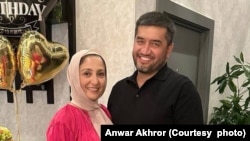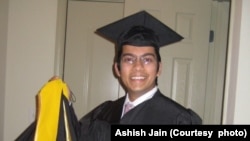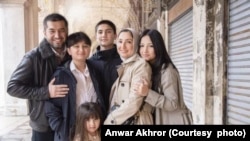Nilufar Akhror, a nurse anesthesiologist from Uzbekistan, and her husband came to the United States through the so-called “green card lottery” program.
Ashish Jain, an Indian tech executive, arrived on a student visa.
Gharzai Oryakhail, an Afghan former military interpreter, won a special immigrant visa.
Akhror, Jain and Oryakhail immigrated to the U.S. during the last two decades, part of a growing wave of migration from South and Central Asia.
Recent Census Bureau data show that the number of immigrants from the region living in the U.S. soared to 4.6 million in 2022 from 2.9 million in 2010, a 60% jump.
Their pursuit of the American dream, however, charts different paths, underscoring a stark reality: People will take any available avenue to reach America.
The Uzbek
Created to attract immigrants from underrepresented countries, the Diversity Visa Program, colloquially known as the green card lottery, is the premiere U.S. immigration path for Uzbeks and other Central Asians.
Akhror says her hometown of Samarkand is famed for its large number of green card lottery winners, its streets lined with signs and ads catering to chasers of the American dream.
Her lucky turn came in 2003. She was finishing university, staring into the uncertainty that greets many new graduates. One day, she returned home and found something rare for that time — a package that had arrived by mail.
Inside was a letter from the U.S. State Department informing her that she had won the green card lottery, one of 1,819 lucky Uzbeks that year. She exploded with joy.
"I was jumping up and down," she recalled. “I was so happy that I’m going to the United States.”
But she hit a roadblock. Single and 19, she was not allowed by her parents to immigrate alone.
The Indian
Jain, encouraged by friends in the U.S., landed in Atlanta in 2007 on a student visa to pursue his master's degree in industrial engineering at Georgia Tech. But his graduation the next year coincided with the financial crisis and the onset of the Great Recession.
“It was bad timing,” he said.
His first job offer fell through. But within three months, he landed another opportunity that allowed him to stay in the U.S. Because fewer companies were requesting H-1B visas during the recession, his visa application was swiftly approved.
Yet what many immigrants don't grasp is just how long a process the American dream can be, Jain said, stressing the word "long."
For Indian students pursuing higher education abroad, the U.S. is a top destination. During the 2022-2023 academic year, the number of Indian students studying in the U.S. soared to a record high of nearly 270,000,
The exact number of Indian students who end up staying in the country remains unknown. But a significant number study STEM subjects and take advantage of up to three years of practical training, notes Jeanne (pronounced Zhaah-nah) Batalova, a senior analyst at the Migration Policy Institute.
“So, these STEM students often with time, maybe not right away, but with time, they find pathways to transition to the H-1B visa,” Batalova said.
The H-1B visa program allows U.S. employers to hire highly skilled foreign workers in specialty occupations. Employers can then sponsor the workers for green cards.
Thanks to their STEM and English language skills, Indians dominate the H-1B visa program. In fiscal 2022, 73% of all H-1B petitions went to Indian nationals, according to government data.
Jain's quest for a green card spanned 14 years. Then came the pandemic, and his lucky break.
The Afghan
Oryakhail's journey to the U.S. began with a special immigrant visa program created in 2009 for Afghans who were employed by or on behalf of the U.S. government.
Over 15 years, the program has become a vital immigration route, providing visas to tens of thousands of Afghans who aided the U.S. mission.
Starting as an interpreter at Bagram Air Base in 2004, Oryakhail, now 41, worked for the U.S. Army for 13 years. His assignments led him across Afghanistan. As a cultural adviser, he rarely went on combat missions, but he encountered many hazards.
“Many times, mines went off on me, and many times in Zurmat District in Paktia Province, we were almost killed because we were surrounded by Taliban, and all our cars and Humvees were destroyed,” he said.
A cousin who also worked for the U.S. Army was caught and beheaded by the Taliban in 2006.
“He was one of the first interpreters that the Taliban beheaded,” Oryakhail said.
Fearing for his life, Oryakhail applied for a special immigrant visa twice, first in 2007 and again in 2010. His second try led to a seven-year wait punctuated by significant life changes — from single to engaged, then married, and eventually a father of two.
"I was always updating my status," he said.
Pathways to the US
Batalova of the Migration Policy Institute says the South and Central Asians' immigration pathways to the U.S. are just as diverse as the reasons for their migration. While Afghans rely on special immigrant visa and refugee programs, many Central Asians try their luck at the green card lottery. Indians typically use work visas as a pathway to become permanent residents and citizens. For Pakistanis and Bangladeshis, it is more common to obtain a green card sponsored by relatives.
The pathways are not always legal. In the past year, U.S. border agents have encountered tens of thousands of undocumented migrants from South and Central Asia. Experts say that reflects the limits to legal immigration channels.
“Some people have been waiting way too long in the line and have attempted to come faster,” Batalova said. “There are also other people who know that they would not qualify through the existing channels or not fast enough.”
Akhror didn't have to resort to an illegal avenue. On the day she won the green card lottery, a suitor's father visited, unaware of her win.
Her family, Akhror says, kept the news to themselves, determined to dodge suitors who were “more after my green card than after me.”
She met and liked her future husband, Anwar. The marriage happened quickly, enabling the couple to move to the U.S. the following year.
Anwar jokes that marrying a green card-winning woman was like hitting the jackpot twice.
“I didn’t know then that I was coming to the U.S. with a green card,” Anwar said.
But coming to America wasn’t without its challenges for the first couple of years. They didn’t have a car and lived in a cramped apartment in Brooklyn, New York. Unable to find a professional job, Anwar worked as a day laborer to pay the bills. Today, he works as a software developer for a hedge fund.
“I used to cry like I want to go home,” Akhror recalled. “He’d be like, ‘I am not the one who brought you here. You’re the one who brought me here.’”
Akhror wasn’t alone in wanting to go back. Many Uzbeks at the time viewed the green card lottery as a temporary ticket to the U.S. to earn money before returning home, she said.
But with their children growing attached to the United States, few returned.
More than 20 years after Akhror moved to the U.S., the lottery still draws many Central Asians. But now, with deeper roots in America, some are exploring other immigration options.
Last year, Akhror helped her parents acquire their green cards, not through the diversity visa program, but through family reunification.
Jain's break came after the pandemic forced the closure of U.S. consulates and embassies around the world, putting family-based green card applications on hold.
“What happens is in any given year if the family-based green cards are not used, they get shifted down to the employment-based category,” he said. “Because of COVID, there was a huge number of green cards available. So, they did a kind of lottery, and I was fortunate to get it because of COVID.”
A process that used to take five years can now run upward of 16, Jain said.
"The queue is getting longer.”
Lengthy delays notwithstanding, most Indians secure green cards through employment. According to the most recent government data, 76% of Indian green cardholders received them through work, a stark contrast to the 27% for all immigrants.
Meanwhile, after a seven-year wait in Afghanistan, Oryakhail was finally issued a visa and arrived in Los Angeles in April 2017. He said he was lucky to leave, but many others who were “lifesavers” have been left behind.
“The people are in danger,” he said. “They can’t find their job there, and they cannot have any sources of income.”
Last month, Congress authorized an additional 12,000 special immigrant visas for Afghans and extended the SIV program through December 2025.
But advocates say that’s not enough to meet soaring demand in the aftermath of Kabul's fall in 2021. With more than 140,000 SIV applications in the queue, immigration to the U.S. remains a distant dream for many Afghans.












